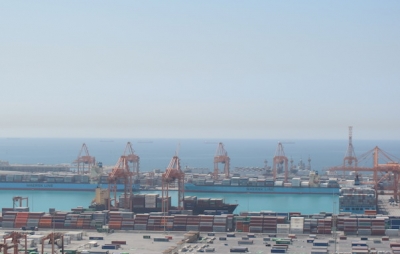Gulf Stevedoring and Contracting Co’s NCT Jeddah to handle 1.8m teu in 2015

Jeddah Islamic Port's North Container Terminal (NCT) is expected to handle around 1.8m teu this year, its most senior official has told Seatrade Maritime News.
“We are likely to reach about 1.8m teu this year. All the major lines are customers,” Mike Power, managing director, Gulf Stevedoring and Contracting Co (GSCCO), said earlier this month.
GSCCO is owned 51% the UAE’s Gulftainer and 49% by the original Saudi shareholders.
NCT capacity is 2.5m teu, he said. “It is the biggest transhipment terminal in Jeddah.”
Red Sea Gateway Terminal, the second operator at JIP, with a concession to 2040, claims to have a capacity of 2m teu a year.
DP World is understood to be handling 700,000-800,000 teu a year at JIP's South Terminal, on capacity of 2.4m teu, following the departure of MSC to King Abdullah Port (KAP) at Rabigh.
Through the acquisition of GSCCO in 2013, Gulftainer acquired the management rights to NCT, as well as two terminals at Jubail Commercial and Industrial Ports.
Power said Jeddah was at the epicentre of global disruption caused by the downturn in freight rates and challenges thrown up by increasing vessel size.
“It's impacted by everything. There's the big ships going up the Red Sea. You've got the ever increasing size of the ships that are now being put on to some services calling in Jeddah. We see some of the lines are consolidating different services due to overcapacity. Every day seems to be a challenge at the moment.”
He said limitations stemming from a draught of 15.2m at NCT were hampering progress. “You have got to look at deepening the quay wall. It's at its limit. So you've got to strengthen the quay walls in order to go down deeper. And then of course you're looking at much bigger, heavier cranes.”
Power said he was positive about the company's proposal to the Saudi Ports Authority (SEAPA) for the retendering of NCT pending the award of a new concession in 2019, where it hopes to remain incumbent.
“The Saudi Port Authority is very keen to develop Jeddah. We believe that, because of the changes that are taking place, and the requirement for ULCS berths, Jeddah needs to be upgraded now so as not to lose any ground,” Power said.
Petrochemicals exports from Jubail Industrial Zone were the driver of growth at the port there. “It has been growing very fast. Last year, it registered 25% growth. This year is a little bit slower, probably in the region of 8%. This year we should finish just over 400,000 teu.”
Although slightly delayed, he said the new Dow Sadara petrochemical export facility had recently come online. “That should produce another 25-30% growth next year,” he said.
He said he also looked forward to more clarity from the authorities on plans for the rail link between Jubail and Dammam.
Gulftainer is pleased with the success of the acquisition to date. “GSCCO had the best reputation in Saudi Arabia before Gulftainer got there. All we've done is enhanced it. It's always been the best operator. We've just brought a bit more expertise and a bit more oomph to it,” Power said.
But he feels that the global uncertainty caused by a crisis in container shipping combined with instability in the region, has presented some challenges.
“I think Jeddah has got some unique geographic features and every element of what's going on in the world, the overcapacity, the big ships coming on, regional conflict, it's all happening in the Red Sea. If you go to other places, they may have one or two of these issues, but not all of them.”
HEADLINES
- Do shipping markets want Biden or Trump for the win?
- All 18 crew safe after fire on Japanese-owned tanker off Singapore
- Singapore launching $44m co-investment initiative for maritime tech start-ups
- Cosco debuts Global Shipping Industry Chain Cooperation Initiative
- US warns of more shipping sanctions
- China continues seaport consolidation as Dalian offer goes unconditional